Ryanair and RegioJet to Kvarner: New Air and Rail Routes Planned for 2022 Tourist Season
January 6, 2022 - The announcement of Ryanair and RegioJet to Kvarner will strengthen connections in the region during the 2022 tourist season.
The pandemic has brought significant changes in the last two years in connecting Kvarner with its most important markets. Last year, after many years, the region was left without Ryanair. On the other hand, in the first pandemic year, a completely new line arrived - the RegioJet railway line from Prague, reports Novi List.
This line proved to be a complete success in the first year, and RegioJet introduced Split into its itinerary last year and changed the route, which included Budapest and Zagreb instead of Ljubljana.
From the end of May to the end of September, they transported a total of 90,000 passengers with an average occupancy rate of more than 90 percent, and compared to 2020; they had 50 percent more passengers.
As things stand, the region expects to strengthen the connection this year, including the return of air traffic.
Ryanair has already announced three routes to Rijeka Airport, and RegioJet, in addition to the current line from the Czech Republic, is also announcing a line from Poland.
Specifically, according to current announcements, Ryanair will fly from Krk to Brussels, London and Stockholm. This low-budget airline, which opened a new base in Zagreb last year, first announced the Brussels-Rijeka route at the end of last year.
There will be flights from Brussels Charleroi Airport from March 27, with the line running twice a week, on Thursdays and Sundays. The B737-800 aircraft with a capacity of 189 seats will service this route, offering more than 23,000 seats on this line. Recall, Rijeka Airport had a direct line with Brussels before the pandemic, only in the peak summer months.
At the end of last year, Ryanair also released tickets for the Rijeka-London route, as usual, for Stansted Airport. However, this line was also canceled after the pandemic, and the region did not directly connect with Great Britain.
On 62 return flights, Ryanair will offer more than 23,000 seats next summer between Rijeka and London. In addition, Rijeka will be connected to Stansted, an hour's bus ride from central London, starting March 27. Fights will run twice a week, on Thursdays and Sundays, throughout the summer flight schedule until the end of October.
From March 27 to October 27, the line to Stockholm is also announced twice a week, on Thursdays and Sundays. Ryanair already flew from Rijeka to Stockholm, but to the secondary airport Skavsta, with this line being interrupted before the pandemic.
Ryanair will now fly to Stockholm's main airport, Arlanda, instead of Skavsta. For now, Condor flights to Düssledorf and Frankfurt, and a Lufthansa line to Frankfurt are also announced.
This year's novelty is that the Czech RegioJet will introduce a new railway line from Poland into its itinerary. Not all the details have been defined, but the recognizable yellow trains will likely run from Krakow.
Namely, RegioJet submitted a draft timetable to the competent Czech railway office, applied in the 2022 summer season. The train will run three times a week, Polish media write.
According to Nakolei.pl, the Railway Office has published a request from RegioJet regarding the launch of a passenger train on the route Kraków Główny - Rijeka / Split - Kraków Główny.
The carrier has expressed readiness to provide a new passenger transport service from June 15 this year to September 26, 2026, with the new service to be provided every year from June to September during the summer school holidays.
This shows that the Czechs are counting on this line in the long run and that they see potential in the Polish market, which this year was extremely important for Croatia and is one of the four strongest markets for Croatia. Namely, Poles achieved an 8% better turnover in Croatia in 2021 than the record 2019.
Therefore, it is clear that RegioJet is counting very seriously on this large Central European market and the desire of Poles to spend their holidays and holidays on the Adriatic.
Preliminary agreements say that RegioJet plans three lines a week, on Mondays, Wednesdays, and Saturdays from the Rijeka / Split station and three lines a week on Tuesdays, Fridays, and Sundays from the Krakow Główny station.
However, in case of high demand for tickets, the carrier leaves open the option of trains running daily during the summer, as is the case with the line from Prague, which runs daily through July and August.
According to Polish media, the train will be available in Poland only in international traffic, so the new RegioJet service will not be available for domestic transport.
Although the RegioJet timetable is still under development, it is estimated that the new railway line would depart from Krakow in the afternoon and pass Katowice, Tychy, Rybnik, Wodzisław Slaski, Ostaw, Hranica na Morawie, Przerów, Otrokowice, Brzecław, Vienna, Wiener Neustadt, Graz, Zagreb and Ogulin.
As with the line from Prague, the train would be divided into two, and one part of the wagon would go on to Rijeka and part to Split. The train will consist of 7 to 15 carriages.
For more on flights to Croatia and other travel announcements, make sure to check out our dedicated travel section.
Epidemiological Measures to Be Tightened After Record Number of Cases
January 6, 2021 - A record 8,587 new cases of coronavirus infection were recorded in Croatia yesterday, and 32 people died. A tightening of current epidemiological measures is expected throughout the country.
After the worst day of the infection, stricter epidemiological measures could be introduced throughout Croatia, such as limiting the work of cafes to 10 pm and canceling gatherings with a larger number of participants, reports Net.hr.
In Croatia, yesterday's record number of positives among those tested, more precisely 8,587 newly infected among 18,689 tested, confirms the virus has been unleashed in another difficult stage of the pandemic. But despite the large numbers, some believe that "omicron is the way out of the pandemic through collective immunity", and thus stricter epidemiological measures are not necessary; something which scientists, disagree with.
The pressure of coastal counties to introduce new stricter measures to at least reduce the rate of coronavirus spread is still strong because, for example, in Split-Dalmatia County, the number of infected among those tested has already exceeded 60 percent and testing capacity is too low, and it records an increasing number of hospitalized and patients on respirators.
With more than 9000 new cases unofficially confirmed today, the Headquarters could introduce some new measures, which would primarily mean shortening the work of cafes until 10 pm and canceling gatherings with many participants until further notice.
The measures will apply to the whole country, not just the coast, probably because the numbers are on the rise in all counties. The proposal to use covid certificates more extensively has not passed so far, although it has long been a routine, for example, in cafes in countries where the vaccination of citizens is much higher than in Croatia.
The latest research by British scientists from the University of East Anglia confirms that hesitation with the introduction of stricter measures in Croatia could result in severe consequences for the health of citizens.
They claim that weak epidemiological measures at the time of virus spread and poor vaccination pose a high risk for vulnerable groups, especially those who must not be vaccinated for some health reason or cannot gain immunity due to their health condition such as those with compromised immune systems.
For all you need to know about coronavirus specific to Croatia, make sure to bookmark our dedicated section and select your preferred language if it isn't English.
Bogojavljenje (Epiphany) - Three Kings Day in Croatia
January 6, 2022 – Thursday 6 January is Bogojavljenje (Epiphany). Three Kings Day in Croatia is a national holiday. It is also a day marked by its own historic and very distinct traditions.
With the fireworks of New Year's Eve almost one week behind us, Christmas already feels like it was quite a while ago. But, with church bells ringing out across the land, Three Kings Day arrives on 6 January to remind us in Croatia that we're not quite finished yet.
Commonly known as Bogojavljenje (Epiphany), Three Kings Day is highly significant in the Catholic calendar. It is also a day of limited but extremely distinct tradition in Croatia. Understanding these traditions requires a comprehension of some Bible scriptures. More so, perhaps, than the traditions of any other feast or celebration days connected to Christmas.
What is Bogojavljenje (Epiphany) - Three Kings Day in Croatia?
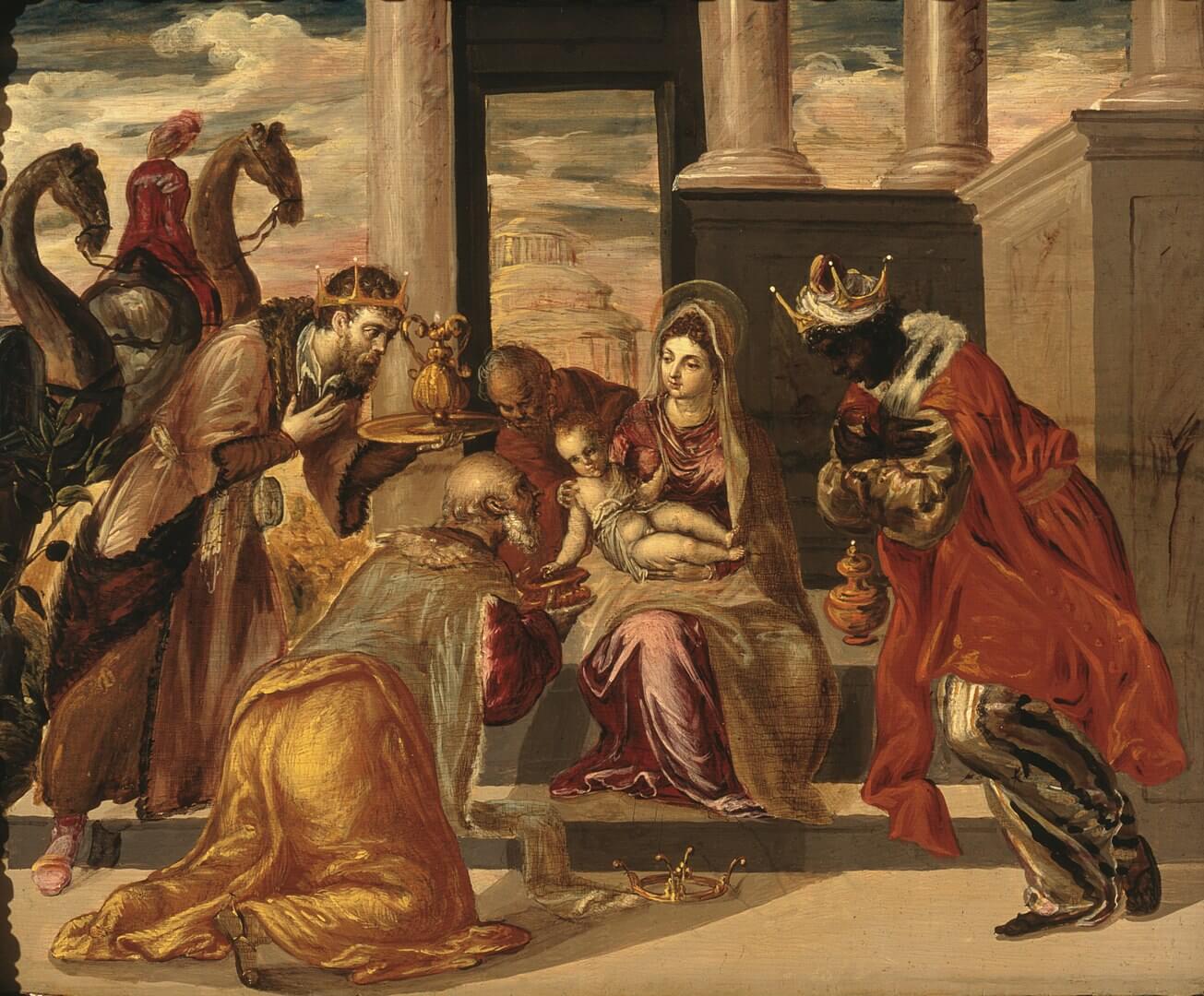 Adoration of the Magi by El Greco
Adoration of the Magi by El Greco
January 6 is celebrated in the Catholic church as both Epiphany and the day of the Three Kings. Epiphany is the revelation of Jesus as the Son of God to those outside Judaism. Three Kings Day is when the three kings – otherwise known as Magi or the three wise men - visit the newly-born Jesus and present gifts to him.
These could look like two different celebrations that just happen on the same day. But, in fact, they are not at all separate. Although, their connection does take some explaining. And the traditions the day creates in Croatia takes even more explaining.
Who are the Three Kings aka the Three Magi?
 The Magi, celebrated on Three Kings Day in Croatia
The Magi, celebrated on Three Kings Day in Croatia
If you've seen a nativity scene or any Christian art related to Christmas, you'll be familiar with the image of the Three Kings. But, actually, they are not in the Bible. What the Bible says is, Magi arrive in Jerusalem at the time of Jesus's birth. They ask the location of the 'king of the Jews' so they can pay tribute. No number is allocated to the Magi.
However, the Bible details that the Magi carry with them three gifts for Jesus – frankincense, gold and myrrh. It is from this number of gifts that the embellished western tradition presumes the number of Magi. In the eastern church, the number of Magi is actually set at 12!
Their number is not the only way their story has been enhanced. Over the years, the Magi have been given very different places of origin. In some of the first embellishments, the kings are said to represent lands of Arabia, Persia and India. But, as Christianity spread, the story changed – perhaps to be either more inclusive or reflect self-importance. Later versions have the kings representing Asia, Africa and Europe. The Bible actually says all three arrive from the east (Africa and Europe are obviously not east of Judea.)
From the 8th century we find the first evidence of the Three Kings being given names - Balthasar, Melchior, and Gaspar (or Casper). In the Bible, the Magi follow a star to reach Jerusalem at the time of Jesus birth. But, they stop and ask directions. Three Kings Day is when they finally arrive to pay tribute to Jesus.
In our celebration of Christmas, this is 12 days after the birth of Jesus Christ. And yet, in every nativity and Christmas painting, shepherds attend the scene immediately after Jesus's birth, closely followed by the Three Kings. To understand what is happening with the Three Kings and the Epiphany you need to look at the Gospel according to Matthew.
Understanding the Gospel according to Matthew
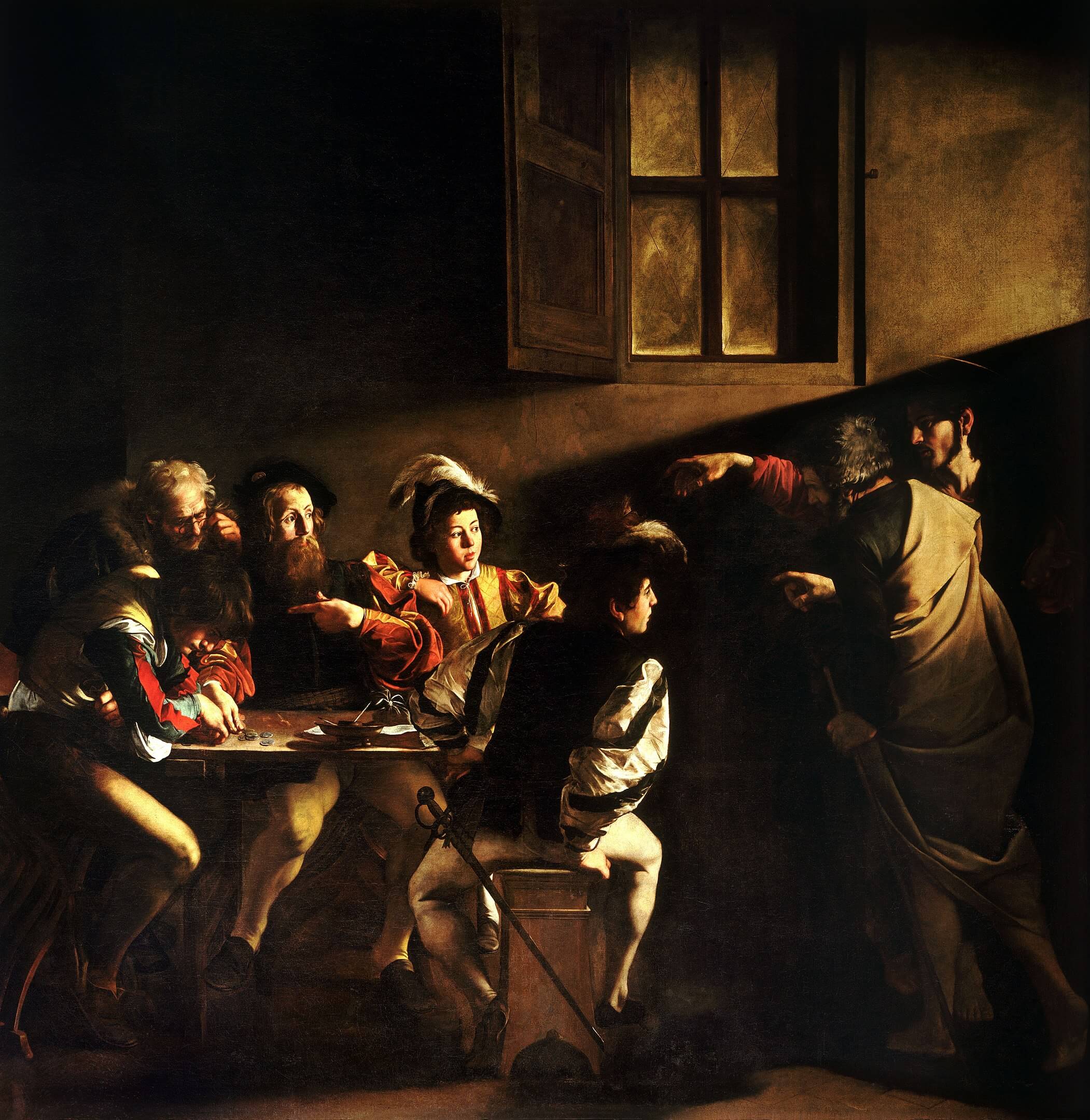 The Calling of St Matthew by Caravaggio
The Calling of St Matthew by Caravaggio
The first three books of the New Testament are Matthew, Mark and Luke. When originally written, they were not intended to be placed next to each other in a single compiled 'book'. And so, within the first three books of the New Testament, we find quite a lot of repetition, as each of these disciples recounts the life and story of Jesus.
The Gospel according to Matthew is arguably the most famous and most detailed of these books. As an example, it is the only book where we are told about the Magi visiting Jerusalem and Jesus. It is also the most Jewish of the Gospels - in structure and in language (it is originally written in Greek).
 The Siege and Destruction of Jerusalem by the Romans Under the Command of Titus, by David Roberts
The Siege and Destruction of Jerusalem by the Romans Under the Command of Titus, by David Roberts
The books of both Luke and Matthew take from the book of Mark, which is widely considered to have been written first. Most scholars today agree that Matthew was written sometime between AD70 and AD100, not by Matthew himself, but by his followers. If accurately dated, the book is written within recent memory of the destruction of Jerusalem and its Jewish temple by the Romans in AD70.
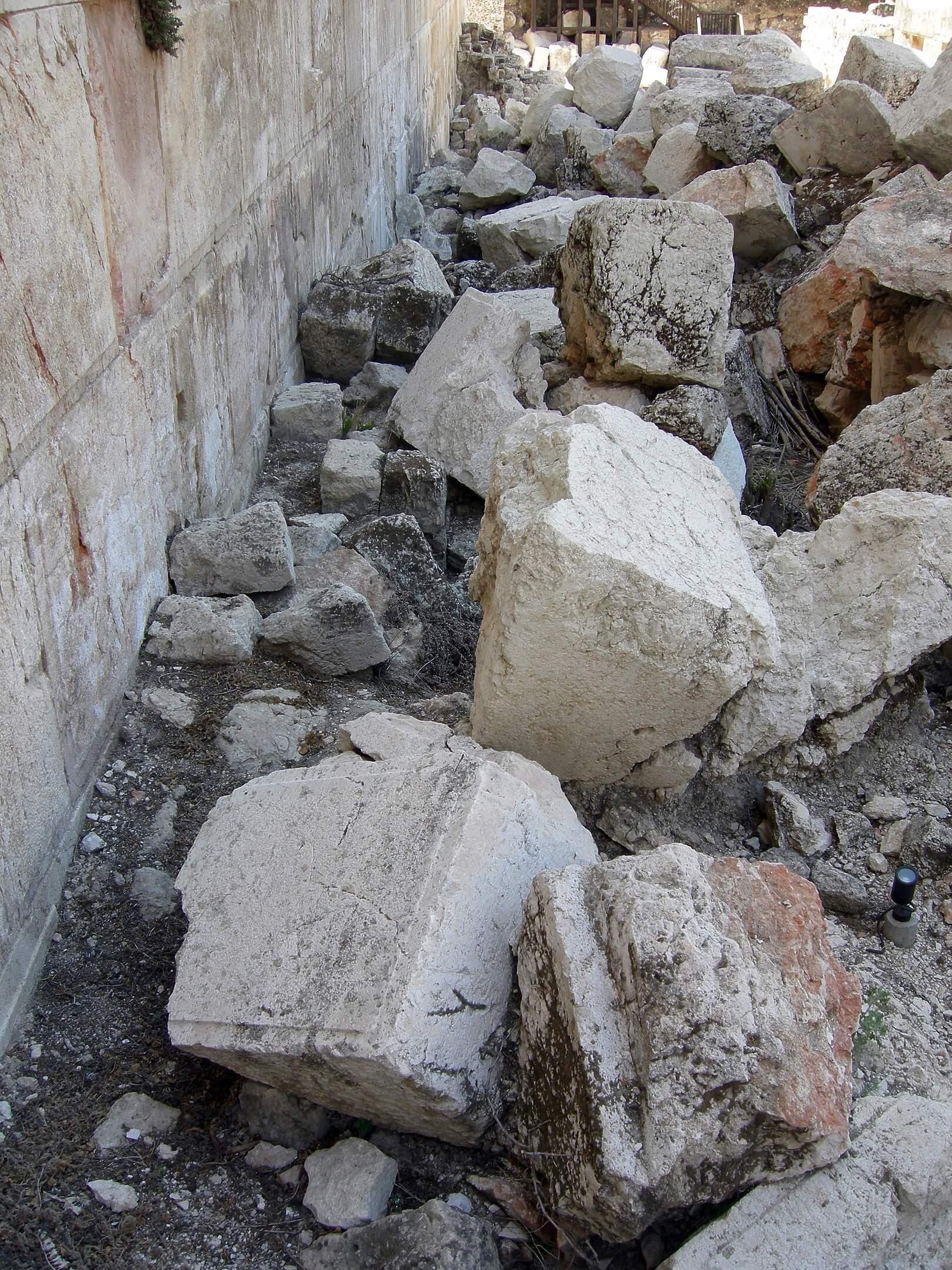 Stones from the Western Wall of the Temple Mount (Jerusalem) thrown onto the street by Roman soldiers in AD70
Stones from the Western Wall of the Temple Mount (Jerusalem) thrown onto the street by Roman soldiers in AD70
In the lifetime of Jesus, His ministry was limited to the land of Judea. Thereafter, the ministry of Matthew was similarly aimed towards Jews. The Gospel according to Matthew begins by carefully detailing Jesus as a descendant of David and Abraham. This is necessary in order for Jesus to be the Messiah spoken of in Jewish prophecy.
Several times in the gospel, Matthew is critical of Jewish Pharisees. But, he is not trying to replace Judaism with a new religion. Instead, he says Jesus is fulfilling Jewish prophecy. He instructs that Jewish scriptures should be more closely adhered to by the followers of Jesus (than they had been by 'hypocritical' Pharisees).
And yet, at the time it was written, a certain separation must have existed between Matthew's followers and many Jews simply because Matthew's followers insisted Jesus was the Messiah. The Gospel ends with the resurrected Jesus instructing “go and make disciples of all the nations". Therefore, Matthew pre-empts the spread of the faith and stands as a bridge between Judaism and the new church. No doubt, this is part of the reason Matthew is the first book of the New Testament instead of the earlier Gospel of Mark.
That the kings come to pay tribute to Jesus in Matthew further fulfils Jewish messianic prophecy. It also positions Jesus as the Son of God for gentiles (non-Jews).
Blagoslov obitelji (family blessing) and the traditions of Epiphany (Bogojavljenje) Three Kings Day in Croatia (Sveta tri kralja)
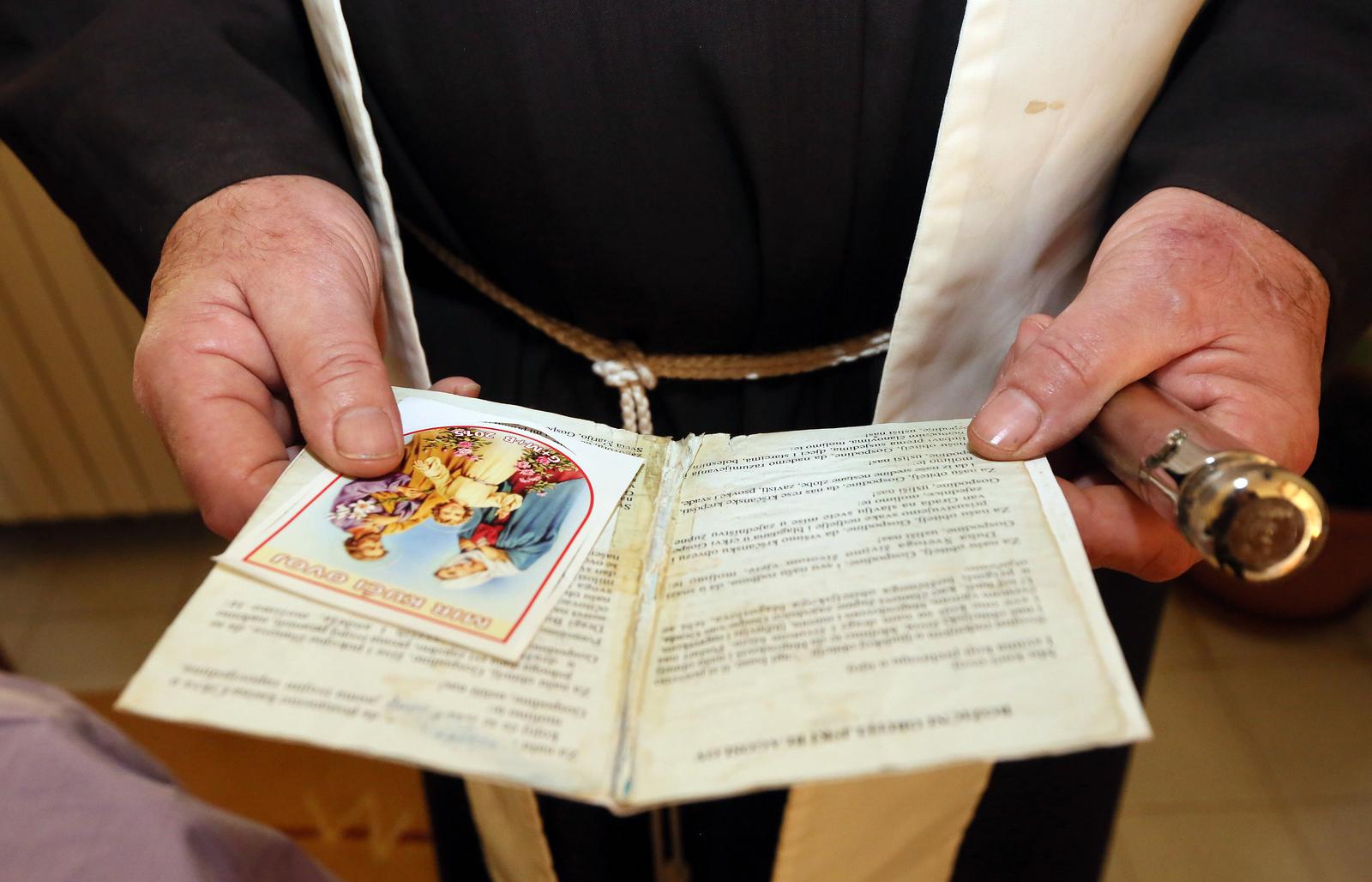 Bogojavljenje aka Three Kings Day in Croatia, by Dusko JaramazPIXSELL
Bogojavljenje aka Three Kings Day in Croatia, by Dusko JaramazPIXSELL
Traditionally, this is the day on which your local priest would visit your home to bless it and the family within. Nowadays, Croatia's population has grown so as to make this impossible. So, in the modern era, the annual blessing of home and family take place between St. Stephen's day (here) and today.
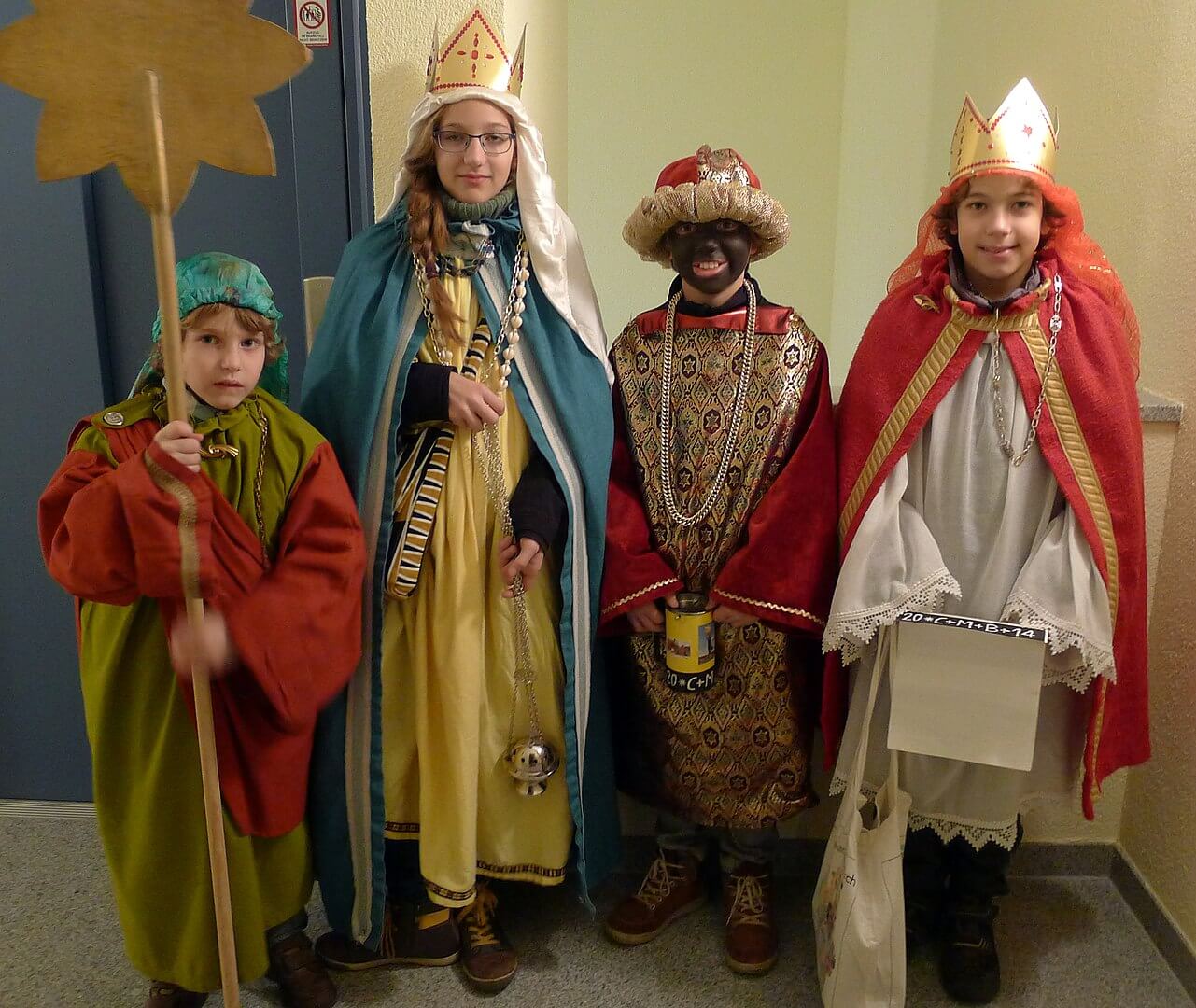 Zvjezdari in Germany, by James Steakley
Zvjezdari in Germany, by James Steakley
This is still a day of Christmas, celebration and decoration. Traditionally, the priest may have been accompanied by altar boys who rang bells to let villagers know they were on their way. These days, the altar boys could be choristers or simply young parishioners. It is not uncommon for them to sing and to be dressed as the Three Kings and carrying a star (Zvjezdari – starmen).
 Collection of stickers marking Blagoslov obitelji (family blessing), awarded on Three Kings Day in Croatia. Note the different spelling of Saint Gaspar (Croatian) / Caspar (Latin)
Collection of stickers marking Blagoslov obitelji (family blessing), awarded on Three Kings Day in Croatia. Note the different spelling of Saint Gaspar (Croatian) / Caspar (Latin)
As part of the home blessing, it was traditional for the priest to sprinkle the home with Holy water. Also, he would write in chalk above the main entrance to the home. The chalked pattern would read 20 ✝ C ✝ M ✝ B ✝ 22 - numbers denoting the year, and the cross separating the letters C (G), M and B. These are the initials of the Magi Caspar (Gaspar), Melchior and Balthazar. They are also an abbreviation of the Latin blessing Christus mansionem benedicat - May Christ bless this house. This chalking of the door signals the home has been blessed for the year and echoes the Old Testament marking of doorways by the Israelites in Egypt. As in Matthew, the tradition of Three Kings bridges Judaism and the new church. Nowadays, the chalk writing has in most instances been replaced by stickers.
 Collection of stickers marking Blagoslov obitelji (family blessing) - these will be added to on Three Kings Day in Croatia
Collection of stickers marking Blagoslov obitelji (family blessing) - these will be added to on Three Kings Day in Croatia
In the distant past of Three Kings visits, a greater significance was put on the blessing of the home and property. But, in order to diminish the supernatural aspect of 'warding off bad spirits from the home', the church has continuously aimed to make the blessing more about the family gathered within. These days, that is reflected in the contemporary wording of the blessing.
This family aspect of the blessing actually goes back an incredibly long way. This time of year is one of the least demanding for those who work in farming or agriculture. It was easier to gather together the full family for the blessing at this time than at almost any other during the year. This tradition still exists – it is customary for the full family to be gathered together when the priest visits.
Another tradition that persists is the cleaning of the home prior to the visit. Although, this is not only because the priest is coming. Remember, Bogojavljenje is Jesus's revelation as the Son of God to all those outside Judea and Judaism – as represented by the Three Kings.
The Three Kings give the gifts of frankincense (signifying his origin from God), gold (signifying his royal status on earth) and myrrh (a balm, signifying that Jesus is a man). The cleaning and blessing of the home welcomes Jesus into Croatian home – as a man he walks among us.
In the modern era, it is customary for the family to give a monetary donation to the priest at the time of the visit. This is not traditional nor is it 'payment' for the blessing or visit. God's blessing cannot be bought or paid for, and is not denied to anyone who asks for it - whether he had money or not. That the traditional annual donation takes place on this visit is a matter of convenience.
Non-Croatian traditions of Epiphany (Bogojavljenje) Three Kings Day in Croatia (Sveta tri kralja)
 Christmas tree recycling, by Ruff tuff cream puff
Christmas tree recycling, by Ruff tuff cream puff
Bogojavljenje is one of the oldest Christian holidays marked in the Croatian Catholic calendar. The fact the day remains a national holiday in Croatia attests to its continued importance.
The laziest and most incorrect contemporary 'custom' attributed Croatian Bogojavljenje is that it's the day you should throw out your Christmas tree and take down your decorations. Wrong. The second biggest modern error is to regard Bogojavljenje as the end of Christmas.
The Christmas tree is not a traditional part of Croatian Christmas. It is German. Its widespread popularity only really began from around 1850 in the UK (thanks to their German monarchy importing it) and from 1870 in the USA. Only after that did the custom travel internationally. To regard the discarding of Christmas trees as a fundamental part of a centuries-old tradition displays an extremely limited and shallow knowledge of Croatian traditions.
In fact, it is Croatian tradition for the local priest to visit the family with the home still decorated. Typically, the priest was fully embraced into the family Christmas setting when he called – jaslice (nativity), candles, log fire, decorations and all. In the past, the priest was usually offered food and drink from the family. In many instances, they would all enjoy the seasonal food together.
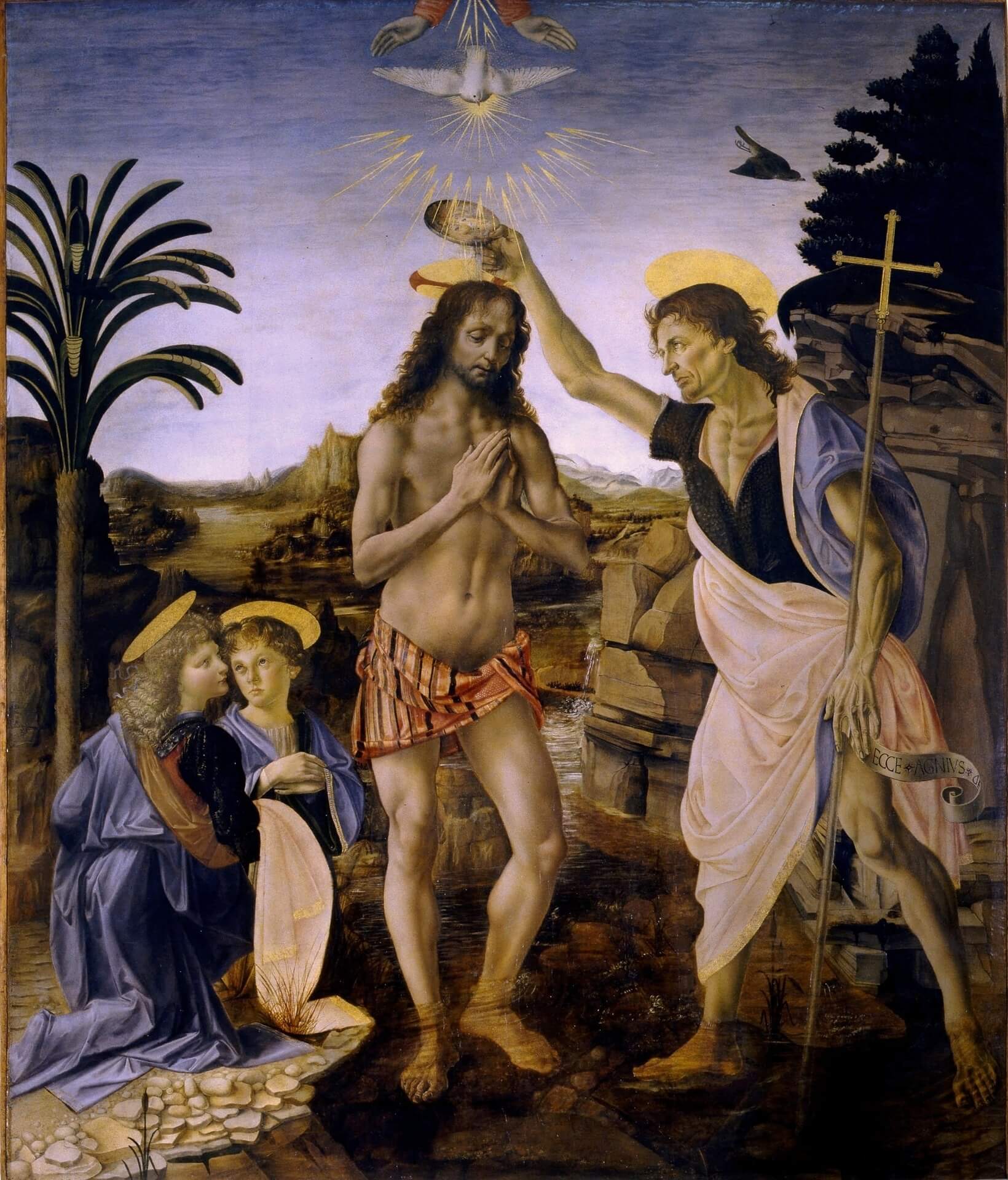 Baptism of Christ, by Leonardo DaVinci
Baptism of Christ, by Leonardo DaVinci
Advent starts on the fourth Sunday before Christmas and ends on Christmas Eve (here). Christmas begins in the evening of Christmas Eve. Like elsewhere, Epiphanytide begins on Three Kings Day in Croatia. But, that does not mark the end of Christmas. In fact for Catholics, Christmas ends officially on the Feast of the Baptism of the Lord, celebrated on the Sunday after Epiphany - Three Kings Day in Croatia (in 2022, Sunday 9 January).
Accordingly, the most traditional of Catholic houses and churches in Croatia can be seen displaying their decorations until then. Three Kings does mark the end of the '12 Days of Christmas', but this is a secular duration of Christmas and has little to do with Croatian tradition.
With grateful thanks to Iris Ćelić, family Kutleša / Marinić, Pater Ivan Dominik Ilicic and Marko Čurković
Split Advent Ends after 40 Days: Four Zones, Daily Concerts, 50 Cultural Programs, and More
January 6, 2022 - Split Advent ends after 40 days full of concerts, culture, gastronomy, and children's activities.
More than 50 cultural programs, over 20 children's events, daily concerts in four locations - Perivoj, Cornaro, Zvončac and Mertojak, dozens of Split caterers with attractive gastronomic offers, New Year's Eve celebrations in four zones, and two skating rinks is a basic overview of what this year's Split Advent offered to visitors under the slogan "Click on Advent", reports Slobodna Dalmacija.
This year, the Cornaro ramparts were introduced on the Advent map for the first time, and due to its size, it has become a central gathering place for all visitors. Cornaro's culinary offer and evening music programs were joined by Perivoj, Imaginarium Advent Zvončac, and Advent Mertojak.
In each zone, visitors could enjoy a variety of delicacies prepared by Split caterers while live music filled the evenings. COVID confirmation was required for all four zones from 7 pm, and those who could not visit the zones live could follow the events on the official Split Advent website.
Fifteen restaurants in Split joined the "Split Restaurants Holiday" event, and promotional prices brought their Advent offer closer to diners, while every Advent Sunday, the traditional Gastroadvent in Split was organized at a different location. Citizens could follow the event via YouTube, which showcased the Mediterranean diet with prosciutto and cured meat products.
Children's performances, a children's cinema organized by Slobodna Dalmacija, and visits by St. Lucia, St. Nicholas, and Santa Claus delighted the youngest residents of Split on Mertojak. It was there that the main children's program was held, where the youngest could enjoy mascots from their favorite cartoons and a mini disco on New Year's Eve.
They also enjoyed the Advent procession and spinning the "wheel of fortune". Some won candies and lollipops, and some won free tickets to the Dardin skating rink. The skating rinks in Dardin and Mertojak were an absolute mecca of the Advent celebration.
There were more than 60 cultural programs as part of this year's Advent. In addition to a dozen concerts at St. Francis Church, the Split City Museum hosted shows that citizens could follow through the YouTube channel of the Split Tourist Board.
The humanitarian concert of the opera diva Antonella Malis in the Croatian Home raised funds to help the Croatian community of laryngectomized persons. This renovated hall hosted many young, talented performers. In addition, the Art Gallery, the Meštrović Gallery, and the Kula Gallery joined Advent with their programs, and the Museum of Croatian Archaeological Monuments hosted film lovers and organized guided tours to the Church of St. Jere and the hermitage cave on Marjan.
The University of Split Campus also joined the Advent program, while the Musical Youth of Split celebrated the 25th edition of the Cro Patria Festival during this event. Furthermore, every Tuesday, Prokultur's Chanson Club Friends brought a festive atmosphere to citizens' homes through songs and stories from all over the world; KUDŽ Filip Dević sang on the Cornaro ramparts and thus increased the holiday spirit. At the same time, KUD Jedinstvo attracted many citizens to the squares of Split.
The "Help Portrait" event was held at the Photo Club Split, where the members of the Photo Club offered free photography, while in cooperation with Slobodna Dalmacija, the exhibition "Schography" by Cropix photographer Božidar Vukičević was displayed. In addition, the Christmas concert at the Croatian National Theater in Split was jointly presented by the Split Tourist Board and the Croatian National Theater in Split, featuring classics to contemporary Christmas carols.
"We imagined this Split Advent in such a way that everyone could find for themselves what they were most interested in and consume it in the way that suited them best. Citizens and all our visitors could follow the content live or through digital channels, which best manifested the slogan of this year's event, 'Click on Advent,'" said the Split Tourist Board director Alijana Vukšić.
To read more about lifestyle in Croatia, follow TCN's dedicated page.
Coach Zlatko Dalić on Croatia Football in 2022 (VIDEO)
January 6, 2022 - Coach Zlatko Dalić spoke with the Croatian Football Federation about what we can expect from Croatia football in 2022.
Croatia national team coach Zlatko Dalić recently signed a new contract with the Croatian Football Federation. Dalić extended his cooperation until the European Championship, which will be played in the summer of 2024 in Germany. Shortly after signing the contract, he revealed his plans and expectations, reports Gol.hr.
What are your biggest motives?
"Now I am certainly much more motivated with the new contract because I want to prove again that we have quality and get the right results again. From that side, the motivation is really huge. We have a great team, great support from the Croatian Football Federation, my staff, and all prerequisites there," Dalić said.
When asked about his next goal, the coach replied:
"My next goal is for Croatia to qualify for the Euros in Germany after Qatar, where we will have great support, I am sure of that."
How do you deal with pressure?
"The pressure is welcome, but it must be positive. Every Croatia national team coach has one goal - to qualify for a big competition. You have to know how to deal with the pressure and keep your peace, and I somehow succeed in that."
He recently strengthened his professional staff with Mario Mandžukić, who joined Ivica Olić and Vedran Ćorluka as former Vatreni assistants. What can they bring to the coaching staff?
"Well, my goal is for all former Vatreni who have merits in the national team, and who want to work as coaches, to be in the national team. Those with their knowledge and charisma can help a lot, Mario will certainly help a lot, we know what kind of player he was, and he will know how to pass that on to the players."
How will you use this year until the World Cup?
"A year is a big period, but we are already preparing for Qatar. We will have two preparatory matches in March, then six more in the Nations League. We don't have any big unknowns, I expect the players to confirm the quality they showed in the qualifiers. The door will be open for players who impose themselves with their game at their clubs."
How difficult is it for you to lead the national team during a pandemic?
"The match in Split against Russia or in Osijek against Slovakia showed how much the national team means to people. In Split, there was rain, bad weather, cold, and an almost full stadium. So, nothing prevented our people from coming to support the national team that serves to reunite us all. The national team brings us together and I think we are doing great things," said Dalić.
You can watch the full interview in the video below.
To read more about sport in Croatia, follow TCN’s dedicated page.
Late Mayor Milan Bandic's Assets Total Three Million Euros?
January the 6th, 2022 - The late Mayor Milan Bandic, who passed away back in spring last year from what was then reported as a massive heart attack, has left a very long legacy behind him. From political scandals and serious allegations to being a longtime corruption suspect followed closely by USKOK, one cannot ever say that the former Zagreb mayor had a boring life.
His widow, Vesna Bandic, about whom we recently wrote, has stated that she doesn't know where all this money ''hidden away with friends'' the late Mayor Milan Bandic was claimed to have, but it seems that the assets we do know about could be worth a massive three million euros in total.
As Poslovni Dnevnik writes, the legacy of the late Mayor Zagreb Mayor Milan Bandic is extensive, and his assets could be worth at least 20 million kuna today, Jutarnji list reported recently.
This is of course if you count the well-known properties, movables and works of art Bandic had possession of both here in Croatia and in neighbouring Bosnia and Herzegovina, which were linked to the former mayor by the Zagreb County Court and are scattered on several sides, some with his brother Drago Bandic and others with the Brzica family from Imotski.
In short, the court attributed four apartments in Zagreb worth about 10 million kuna, a cottage in Samobor, some works of art and oldtimers, and a property in Herzegovina worth 10 million kuna to the late Mayor Milan Bandic.
The story of Milan Bandić's mythical properties and assets, which is almost impossible to trace in its entirety, was recently updated by Bandic's widow Vesna Bandic, who said in an interview with Jutarnji that she could soon be left without everything, about which you can read in more detail in the link provided above. According to official data, only a part of Bandic's estimated legacy now belongs to her.
In the interview, she said that after her husband's death, she owned a part of the property Buzanova street, a cottage in Samobor and a part of the property in Herzegovina, a luxurious property in Grude in an area that has become known for being closely tied to Bandic and his cash. The problem now, according to Vesna Bandic, is that she cannot reach an agreement with her late husband's brother, Drago Bandic, on how to divide up the property.
Public cadastral data shows that only two properties now officially belong to Vesna Bandic. Half of the apartment in Buzanova street and a cottage in Samobor. Specifically, she owns a 176-square-metre apartment in Buzanova 4, which consists of a 119-square-metre attic living space, a 54-square-metre terrace, some basement storage and a garage space.
For the other three properties, apartments in Kruge, Jarun and Gracani, Vesna Bandic says that she has never heard of them and that they didn't appear among his registered properties. However, the court found that these apartments, formally owned by the Brzica, Mate and Silvana families from Imotski, could allegedly also belong to Bandic and that Bandic used them, according to Jutarnji list journalist Filip Pavic.
For more, check out our dedicated politics section.
Tourist Board Expects Good Croatian 2022 Tourist Season, Higher Wages
January the 6th, 2022 - The Croatian 2022 tourist season has some excellent expectations attached to it as we slowly but surely begin to emerge from the public health crisis the globe has been plunged into since the spring of 2020.
As Poslovni Dnevnik/Marija Crnjak writes, although it doesn't expect tourist traffic to return to pre-pandemic levels before 2023, the Croatian National Tourist Board (CNTB) is entering the new year with optimistic expectations of continued traffic growth after the remarkably successful 2021 summer season.
On the wings of optimism, they plan to increase revenues this year, especially from tourist/sojourn tax, as well as increase expenditures for their own salaries. The biggest novelty this year, however, will be the new Strategic Marketing Plan, which is set to go down in history with the famous slogan "Croatia Full of Life/Hrvatska puna zivota" and the entire communication strategy that accompanies it.
All this can be taken quite clearly from the recently adopted CNTB Annual Work Plan for 2022. Even if we fail to achieve the results from 2019 this year, the CNTB expects that the high satisfaction of guests who visited various Croatian destinations last year, good value for money and confidence in Croatia's safety measures will position the country among the top destinations in southern Europe and the Mediterranean as a whole.
The Croatian 2022 tourist season is even expected to reach 90 percent of pre-pandemic 2019's tourist traffic. The focus will be on markets from which Croatia can be driven to, as well as European aviation markets such as Scandinavia, the United Kingdom, Russia as more distant markets are recovering much more slowly than European countries are.
This could be further aggravated by the further increase in overall costs for carriers, and consequently airline tickets. Similar problems also await tour operators and agencies.
The growth of tourist traffic in 2022 will also bring higher revenues to the CNTB, primarily from tourist/sojourn tax, the amount of which should increase by as much as 40 percent this year compared to the previous rebalance. The total revenues of the CNTB for 2022 are planned in the amount of 311.4 million kuna, which is 6.3 percent more than in last year's supplementary budget.
Of this, 91.3 million kuna relates to revenues for special funds, the Fund for Underdeveloped Tourism Areas and the Fund for Associated Tourist Boards, while the CNTB plans to generate revenues in the amount of 220 million kuna by the end of 2022.
The plan is also to increase the total revenue from the tourist/sojourn tax by 40 percent when compared to the supplementary budget for 2021, ie the planned revenue in the amount of 114 million kuna. Membership fees should remain the same as in they were in supplementary budget last year, standing at around 31 million kuna, and the plan is to generate 49 million kuna in revenues from the state budget (about 4 percent more than last year).
As such, the implementation of the new Ordinance on salaries, allowances and compensations is planned, which will come before the Tourist Council for a final decision. Although this is not stated specifically, it is to be assumed that the aforementioned ordinance will increase salaries in the CNTB which were reduced during the pandemic, because higher wage expenditures are planned, from 17 million kuna of expenditures in the previous (2021) supplementary budget to 18.7 million kuna in the plans for 2022.
The drafting of the Strategic Marketing and Operational Plan of Croatian Tourism for the period 2022 to 2026 (SMOPHT) will cost around 3.5 million kuna.
According to the CNTB's current work plan, the new SMOPHT will define a new visual identity and communication concept for the promotion and presentation of Croatia as a tourist destination for the Croatian 2022 tourist season, and until the adoption of a new umbrella form of communication, the guidelines of the "Full of Life" communication concept will continue to be used.
Following the adoption of SMOPHT, which will provide strategic guidance, a new advertising umbrella communication concept for the next few years will be created in collaboration with various marketing agencies. The new communication concept will be used to promote the umbrella brand of Croatian tourism at all levels.
An international tender will be launched to select highly specialised agencies to then be selected to develop a new umbrella communication concept, a new logo, brand architecture, photo and video production and an implementation manual. The planned deadline for the preparation of the tender and implementation is autumn 2022, according to the plan. Therefore, the slogan "Full of Life" will continue to be used for almost a year, although its abolition was talked about back in 2017, when the then Minister Gary Cappelli announced a change in the slogan, claiming that it never came to life on the market. "Full of Life" was introduced back in 2015 during the term of Darko Lorencin, replacing the slogan "The Mediterranean as it once was/Mediteran kakav je nekad bio".
When it comes to the promotion of the country ready for the Croatian 2022 tourist season across foreign markets, the CNTB plans to initiate the procedure of opening representative offices in Spain and Ukraine in the second half of the year, if financial opportunities are created and allow for that. Further investment in the domestic market is also planned.
With the aim of developing and stimulating domestic demand outside the summer season, the CNTB still plans to conduct three major campaigns right here the domestic market, the Croatian Tourism Month campaign, the Experience Domestic Campaign, Explore Rural Croatia, and the Croatian Tourist Card Promotion Campaign. On top of that, the all but totally forgotten Croatian Tourist Card promotion will be revived.
The campaign for the promotion of the aforementioned Croatian Tourist Card aims to raise awareness of the benefits of using the card by Croatian employers, as well as to acquaint end users with the opportunities and benefits that this card provides, they explained from the CNTB when discussing the Croatian 2022 tourist season.
For more, check out our travel section.
Croatian Wellness Shots Succeed at Home, Foreign Markets Targetted
January the 6th, 2022 - Croatian wellness shots made by the company Green and Organic have been doing very well right here on the domestic market for four years now, and now they're eyeing the world beyond the borders of Croatia.
As Poslovni Dnevnik/Marta Duic writes, these Croatian wellness shots, small organic juices designed to boost human immunity, based on fruits and spices, have successfully conquered the domestic market. Behind this project lies a family story, four flavours are on offer, and their products are present across more than 100 outlets throughout Croatia.
“At the same moment in which I was thinking about changing jobs, I decided to leave a secure corporate job and embark on an entrepreneurial venture for the first time. Although it wasn't at all easy at the beginning, we started as a family to produce organic chokeberry juice that we grow in our own fields. Soon after founding my company, I realised that the competition is actually quite high and that it isn't easy at all to stand out in the market. At the time, almost everyone had chokeberry and we struggled a lot until we managed to put our juices on the shelves of the first stores. After a lot of research and thoughts about what to change, we decided to introduce a new product that wasn't yet present on the Croatian market,'' recalled Hermina Skular, the woman behind these Croatian wellness shots.
Only top quality raw materials are used
As she explained, they wanted to make juices with top-quality raw materials, without additives and sugar, which can be drunk by adults and children, and at the same time supply them with vitamins and strengthen their overall immunity.
''Because we love spices ourselves, we decided to make a combination of organic fruit juices with spices. These Croatian wellness shots are small 75 ml juices that literally fit in your pocket and can be taken everywhere with you. The idea was that they could be taken to work, on a trip and be carried along to various sporting activities. First we offered shots with turmeric and ginger, and then we added cinnamon and matcha. Ginger is the most popular, while the children love cinnamon,'' Skular revealed.
Since the beginning of their business story, their focus has been on specialised health food stores and organic products, so it isn't surprising that they are on the shelves of bio & bio and the like, they're also present in cafes and in retail chains such as Konzum.
The wellness shot production itself is located in neighbouring Slovenia, while the chokeberry juice is produced here in Croatia and has its own cultivation, and the rest of the necessary ingredients are procured from abroad.
''If necessary, we cooperate with domestic companies, and we try to work with small enterprises on various projects because we try to stick together and help each other. Given the situation with the coronavirus pandemic, I can say that the past year has been very successful.
We're satisfied with our sales results because it has been shown that our customers, especially now, need something to strengthen their immunity, and that healthy juices are a great choice. Until last year, we offered shots in three flavours - ginger, turmeric and cinnamon, and last year we came out with a new product, a matcha shot,'' noted Skular.
Although their current business is based here in Croatia, they plan to place their products on foreign markets as well. "Since we opened the company, we've been thinking about changes and new products, listening to customer needs and monitoring the market situation. Based on that, we're designing some new flavours. The technologist of the food technology industry has the final say on the exact ''recipe'', and we can suggest a taste. This is one of our favourite parts when designing a new product.
We have a lot of plans, and we hope that some of them will come true in the year ahead. We'll try again to come up with something that is not yet present here on the Croatian market, and we hope that it could be very well accepted by customers,'' concluded Skular.
For more, check out Made in Croatia.
HPB and Croatian Post Form Strategic Partnership to Improve Services
January the 6th, 2022 - Hrvatska postanska banka (HPB) and Hrvatska posta (Croatian post) have come together and signed a framework agreement on strategic partnership, all done with the aim of improving things for their end customers and clients.
As Poslovni Dnevnik writes, HPB and Croatian Post decided to put their heads together for the benefit of their many customers and clients and as such signed a new Framework Agreement on Strategic Partnership and Outsourcing back on the 31st of December 2021 with the primary aim of improving the level of the customer service they both offer.
The strategic partnership between HPB and Croatian Post and the implementation of the useful ''Bank at the Post Office'' project has as such created the largest business network offering banking services to individuals in the smallest and most remote places across the country, and back in 2020, this project was expanded to provide banking services in this manner to business users as well.
Thanks to this decision on forming a strategic partnership, individuals have now have the possibility to make Croatian kuna payment transactions and contract and use the aforementioned bank's products and services across 1,016 post offices, and services are available to business entities at 987 different locations, scattered across the country.
In this regard, the ''Bank at the Post Office'' project has made banking business accessible to all those across the Republic of Croatia who didn't, at least until now, have the necessary services close to their places of residence and within their local communities, which is also the greatest value of this unique and praiseworthy project.
In this context, the preparation of the Framework Agreement was extremely demanding, given that it is a complex legal and business process that is extensively regulated and subject to strict regulatory provisions, despite all of the red tape, HPB and Croatian Post succeeded.
For more, check out our dedicated business section.
What Do X-Rays, Bullets and The Sound of Music Have in Common?
January 5th, 2022 - On this day in 1896, the discovery of X-rays first made the news. The groundbreaking invention soon had its Croatian debut, and once you start looking into the story, it quickly becomes apparent what a lively place Rijeka was at the time. Join us as we go down a historical rabbit hole, featuring a naval academy, a few visionaries - and Captain von Trapp
On January 5th, 1896 a groundbreaking scientific discovery was presented to the public. The Austrian newspaper Wiener Presse first reported that Wilhelm Röntgen discovered a new type of radiation - X rays.
While the German scientist himself named the radiation ‘X’, to this day it’s referred to as Röntgen rays in many European languages, including Croatian (getting an X-ray translates to taking a Röntgen).
A lesser known fact is that X-rays made their Croatian debut shortly after the first international reports of Röntgen’s discovery.
In the late 19th century, the Royal Naval Academy in Fiume (Rijeka) used to be one of the leading educational and scientific institutions in the Austro-Hungarian empire. Its prestigious reputation attracted a lot of talent from all over the empire, including an Austrian physicist named Peter Salcher.

Peter Salcher (1890)
Salcher joined the academy as a physics and mechanics professor, and soon became head of the meteorological station. He was a Renaissance man of sorts, a curious mind interested in science at large, as well as scientific photography and photojournalism.
It’s no wonder that the news of Röntgen’s discovery piqued his interest. On February 21st 1896, Salcher held a public lecture in Rijeka at which he demonstrated the usage of X-rays. Naturally, the local high society was eager to attend the thrilling presentation, among them baroness Josephina Mollinary-Vranyczany.
The baroness bravely volunteered as a test subject for the curious invention, and so Salcher took an X-ray of her hands before the excited audience, the first X-ray image created in Croatia. This one:

X-ray image of baroness Josephina Mollinary-Vranyczany's hands (1896)
Shortly thereafter, the city hospital in Rijeka adopted the invention and began using an X-ray device.
This is not the only thing Salcher’s remembered for, as he was the man behind another groundbreaking scientific experiment that took place in Rijeka. A decade before X-rays were invented, Salcher made history by recording the flight of a bullet shot from a firearm using a special high-speed photography technique.
He devised the experiment after he’d been approached by Ernst Mach, a physicist who was having trouble proving his shockwave theory in practice. Salcher got to work with the help of his associate Sándor Riegler, resulting in 80 shots of supersonic flying bullets. It was the first such achievement in history, and the images can be seen at the permanent exhibit at the Rijeka City Museum.
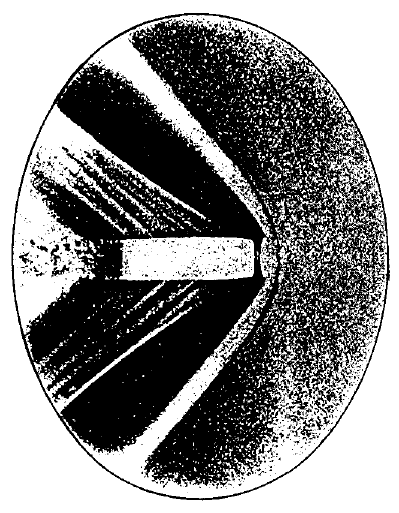
An image of a flying bullet taken by Peter Salcher (1886)
At this point, we very well might be playing six degrees of separation. Many prominent figures were part of the scientific community in Rijeka back in the day, including a particular student of professor Salcher who would later gain international fame.
It was Georg von Trapp - yes, that von Trapp, the head of the family whose story inspired The Sound of Music. A member of a noble family of Austrian origin, Georg Ludwig von Trapp was born in Zadar and entered the Naval Academy in Rijeka at the age of fourteen, which led to an illustrious military career as a naval officer.
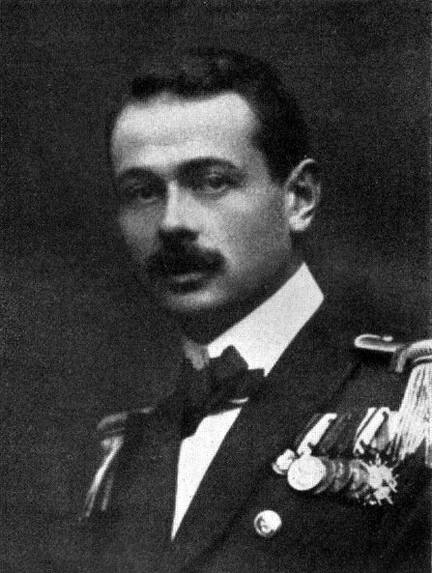
Georg Ludwig Ritter von Trapp
Von Trapp married Agathe Whitehead, granddaughter of Robert Whitehead, the inventor of the modern torpedo and founder of the world’s first torpedo factory. The couple met at the launch of a newly built U-boat in Rijeka where Agathe had the honour of christening the vessel; Georg reportedly fell head over heels for her at the celebratory ball on the same evening. They were married after a two-year courtship - learn more about their love story on the pages of the Georg & Agathe Foundation.
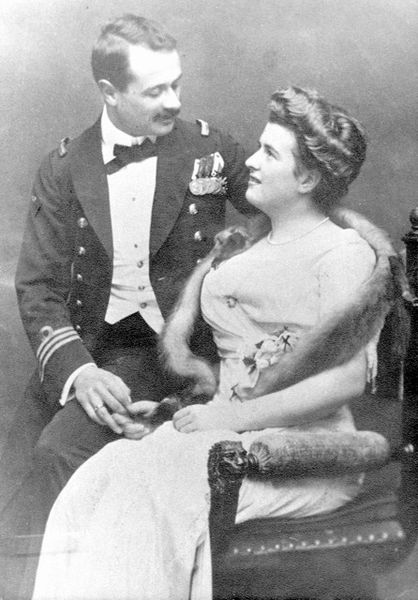
Georg von Trapp and Agathe Whitehead (circa 1909)
Agathe died of scarlet fever in 1922, and Georg moved into a villa near Salzburg with their seven children. You surely know how the rest of this story goes - he hired Maria Augusta Kutschera as the kids’ tutor, they got married a year later and had three more children together. Since everyone in the family was musically gifted, they soon started performing as a vocal ensemble around the world, eventually moving to the United States.

The Trapp Family ensemble at a 1941 performance
Maria Augusta wrote a memoir about the musical journey of the von Trapp family. It served as inspiration for several German films, the 1959 Broadway musical, and the 1965 film The Sound of Music.
So many good stories, all connected to each other - it seems Rijeka really was the place to be at the turn of the century, wasn't it?


